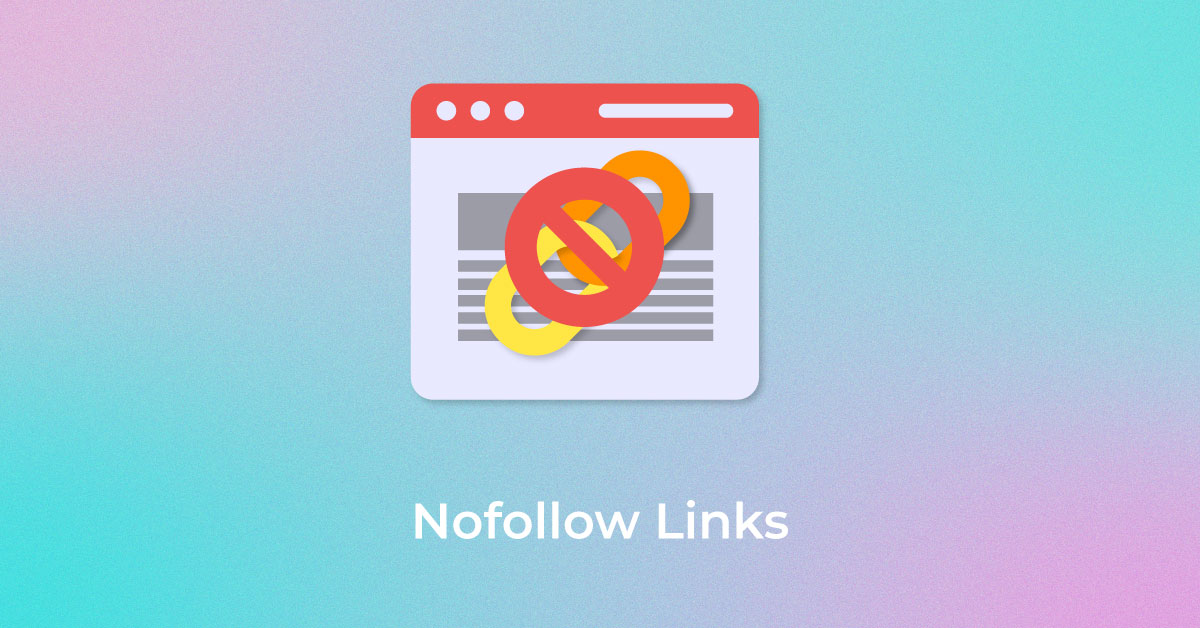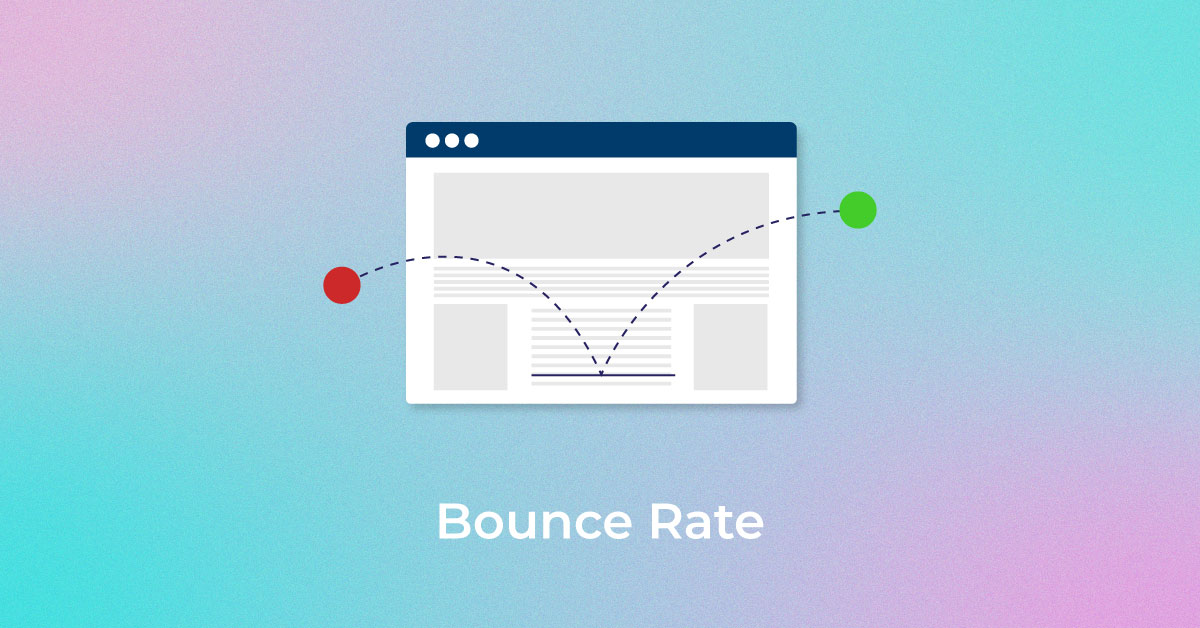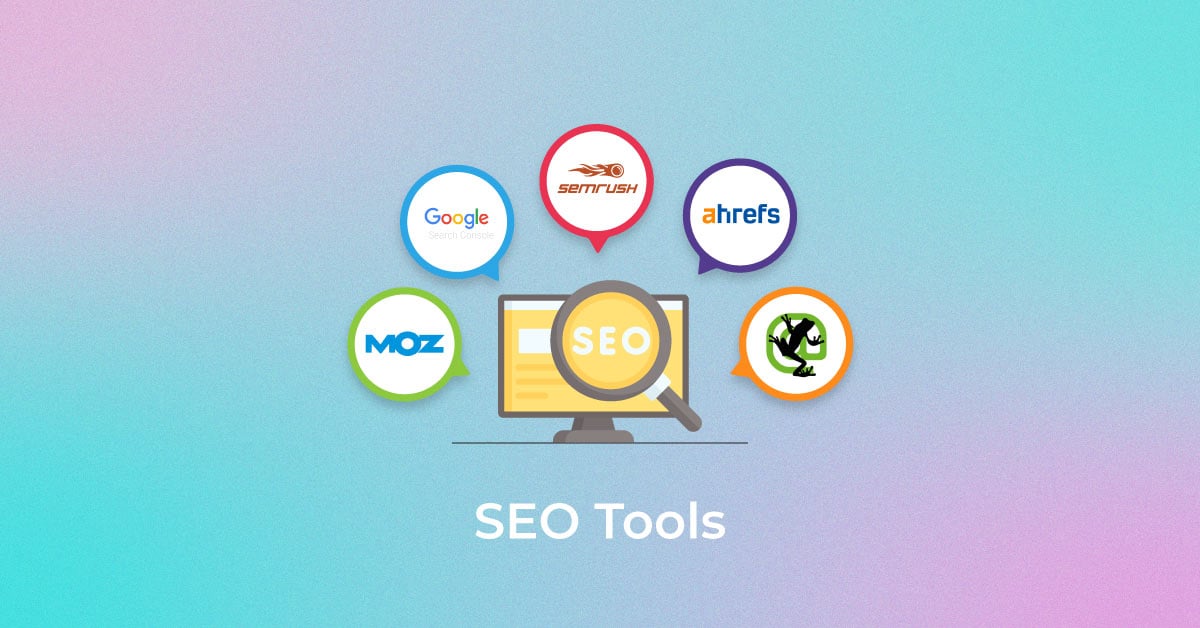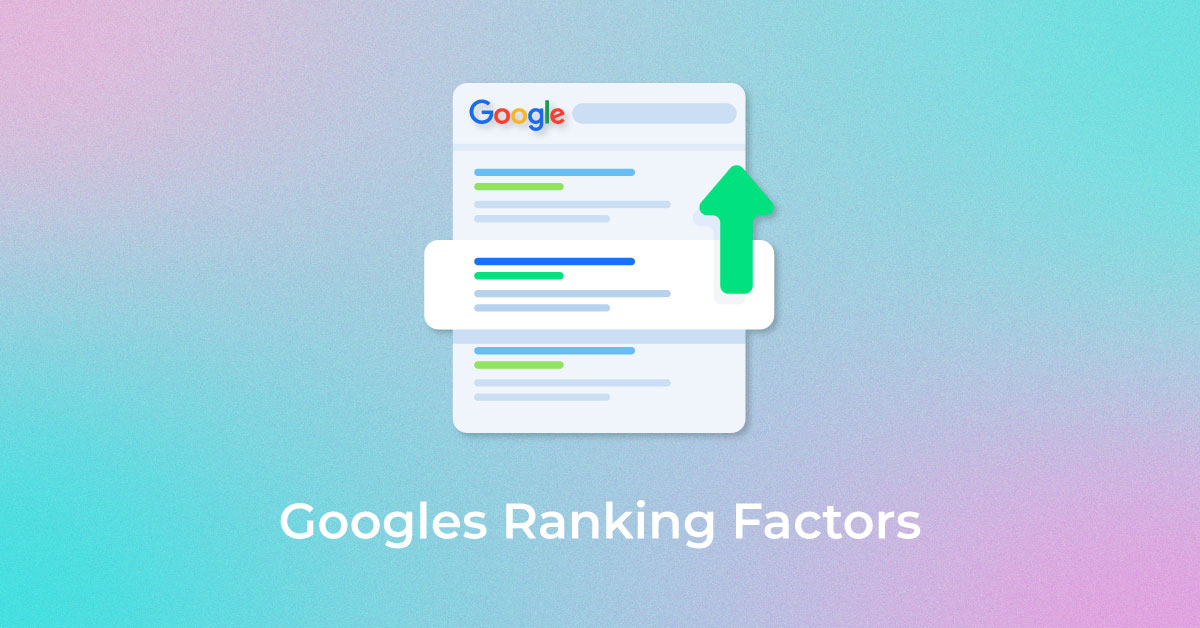In today’s digital world, it is important to be in the know about all the ways you can gain more organic traffic on your website. While terms like SEO-friendly website design, technical SEO, image optimization, and more are thrown around by everyone in the industry, they can be quite overwhelming for beginners.
In this article, we will focus on why creating an SEO-friendly website is important, and how you can seamlessly do it.
What is an SEO Friendly Website?
An SEO-friendly website is one that is technically sound, user-friendly, and search-focused. It integrates both the technical elements required for search engine indexing—ensuring search engine crawlers can easily assess the website—and the usability features that enhance user experience. In simple terms, an SEO-friendly website ensures that search engine crawlers can easily understand its structure and content.
Let’s explore how to make SEO friendly websites and the most important characteristics of one:
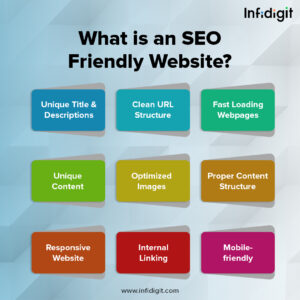
1. Unique Titles and Descriptions for all Pages
For an SEO-friendly website, every webpage must have its own unique meta title and description. Meta titles should range between 50-60 characters and include primary keywords to improve search engine visibility. Meta descriptions, which can go up to 155 characters, should provide a clear and compelling summary of the page’s content while incorporating relevant keywords naturally. These elements not only aid search engine indexing but also improve click-through rates by enticing users to visit your site. Ensure that the titles and descriptions accurately reflect the page content to avoid misleading visitors, which could harm your rankings in the long run.
Unlock higher rankings, quality traffic, and increased conversions through tailored award-winning SEO strategies.
Elevate your web presence by Infidigit’s SEO solutions.
Unlock higher rankings, quality traffic, and increased conversions through tailored award-winning SEO strategies.
2. Clean URL Structure
A clean and simple URL structure is essential for an SEO-friendly website. URLs should be easy to read, descriptive, and follow best practices for search engine indexing. Ensure they are in lowercase, use dashes to separate words, and organically include relevant keywords for better visibility. Avoid using special characters, unnecessary parameters, or overly long URLs, as these can confuse both search engines and users. A well-structured URL not only improves your site’s ranking potential but also enhances user experience by clearly indicating the content of the page.
Also, Read More:- How to create SEO friendly URL Structures?
3. Fast Loading Webpages
Fast-loading webpages are a cornerstone of an SEO-friendly website. Visitors are likely to abandon a page that takes too long to load, impacting both user experience and search engine rankings. Conduct a thorough SEO audit to identify factors slowing down your site. Key improvements include optimizing images, leveraging browser caching, reducing server response times, and minimizing CSS, JavaScript, and HTML. Prioritizing page speed not only aligns with search engine ranking algorithms but also boosts user engagement and retention, giving your website a competitive edge.
4. High-Quality and Unique Content
High-quality, unique content is essential for creating an SEO-friendly website. Ensure that every page features original, engaging, and informative content that adds value to your audience. Plagiarized or duplicate content is penalized by search engines, which can significantly harm your rankings and credibility. Focus on crafting content that aligns with your target audience’s needs while incorporating relevant keywords naturally. Regularly updating and refining your content helps maintain its relevance and enhances your website’s SEO performance over time.
5. Image Optimization
Image optimization is crucial for improving your website’s SEO and overall performance. Large, unoptimized images can significantly slow down page loading speeds, negatively impacting user experience and search engine rankings. To avoid this, compress images without compromising quality and choose the appropriate file formats, such as JPEG for photographs and PNG for graphics. Additionally, add descriptive and keyword-rich alt text to help search engine crawlers understand the content of the images, which also improves accessibility for visually impaired users. Proper image optimization not only boosts your website’s speed but also enhances its SEO friendliness.
6. Structured and Organized Content
Structured and organized content is a key aspect of an SEO-friendly website. A well-defined content structure not only improves user experience but also makes it easier for search engines to crawl and index your site. Each webpage should include these essential elements:
- Header: Sets the tone and provides navigation cues.
- H1 Tag or Page Title: Clearly communicates the main topic of the page.
- Content with Subheadings: Use H1, H2, H3, and other tags to distribute content logically, enhancing readability and SEO.
- Author Bio/Information: Adds credibility and a personal touch to your content.
- Footer: Provide additional navigation and relevant links, enhancing site usability.
A well-structured webpage not only improves content flow but also signals to search engines that your site is organized and relevant, boosting its SEO performance.
Also, Read More:- How to create SEO Content?
7. Responsive Design for All Devices
A responsive design is essential for ensuring your website performs seamlessly across all devices, including desktops, tablets, and smartphones. Search engines prioritize mobile-friendly websites, making responsiveness a critical factor for maintaining your site’s SEO health. Regularly test your website to identify and fix any issues that might make pages unresponsive on certain devices. Implementing a mobile-first design approach and ensuring fast loading times across all platforms not only improves user experience but also strengthens your site’s rankings in search engine results. A fully responsive website ensures accessibility and usability for all visitors, boosting overall engagement.
8. Effective Internal Linking
Effective internal linking is a cornerstone of an SEO-friendly website. It creates a cohesive map of your site, guiding search engine crawlers to understand the relationship between different pages. By strategically linking relevant pages, you can establish a strong internal architecture that improves site navigation and boosts your SEO performance. Internal links distribute link equity across your site, helping important pages rank higher in search results. Additionally, they enhance the user experience by allowing visitors to discover more valuable content, increasing engagement and reducing bounce rates.
9. Mobile Friendliness
A mobile-friendly website is essential for providing a seamless user experience across all devices, including smartphones and tablets. Search engines now prioritize mobile-friendliness as a key ranking factor, making it critical for your site’s SEO success. Ensure that your website’s design is responsive, loads quickly, and displays content clearly on smaller screens. This not only improves user experience but also aligns with search engine algorithms that favor mobile-optimized sites in their rankings. Regularly test your site’s performance on different devices to maintain its mobile-friendliness and overall SEO health.
Why is Having an SEO-Friendly Website Important for a Business?
Now that you know about what makes a website search engine friendly, let’s dive into how it is beneficial for your business.
1. Helps in Increasing Organic Traffic
An SEO-friendly website can improve its visibility in search engine results pages, which can lead to increased traffic to the website. This increased traffic can help businesses reach a wider audience and potentially generate more leads and sales.
2. Increases Your Brand Credibility
If your website ranks on the first page of search engines, users are more likely to trust it over the others options. This is a great way of increasing the brand credibility, not only for users but also for the search engine themselves.
3. Cost-Effective
SEO is a cost-effective marketing strategy compared to other forms of digital marketing. By optimizing their website for search engines, businesses can potentially attract more traffic and generate more leads and sales without spending large amounts of money on advertising.
4. Improves User Experience
An SEO-friendly website is designed to provide a good user experience, with well-organized content, easy navigation, and fast loading times. This can help keep users engaged with the website and improve the chances of them converting into customers.
An SEO-friendly website is designed to provide a good user experience, with well-organized content, easy navigation, and fast loading times. This can help keep users engaged with the website and improve the chances of them converting into customers.
Best Practices for Creating an SEO Friendly Website
1. Use Responsive Design to Engage All Device Users
Responsive design is crucial in today’s digital age, as users may access your website from various devices, including smartphones, tablets, and laptops. Over 54% of searches were conducted on mobile devices in 2020, highlighting the need for a responsive design. A responsive website adjusts to fit any screen size and resolution, ensuring a smooth user experience regardless of the device. This adaptability not only enhances usability but also positively influences search engine rankings by aligning with user intent and preferences. A responsive design helps retain visitors longer, reducing the likelihood of them turning to competitors with smoother user experiences.
Example: Think of a website that automatically resizes its images and text when viewed on a smartphone compared to a desktop. This ensures that visitors on different devices have an optimal browsing experience, which in turn boosts engagement and SEO performance.
2. Integrate Targeted Keywords Throughout Content
Integrating targeted keywords throughout your content is key to driving traffic and generating leads. Unique and valuable content boosts domain authority and ranks higher on search engine result pages (SERPs) for relevant search queries. Effective keyword research identifies high- and low-competition keywords that are relevant to your website’s niche. Long-tail keywords, usually specific phrases like “top-rated insurance company in Bangalore,” attract more qualified leads. After identifying these keywords, incorporate them naturally into different content formats—blogs, videos, infographics—to match your marketing goals. Using targeted keywords smartly enhances your site’s visibility and SEO performance, helping it stand out to search engines.
Example: If you’re targeting a keyword like “SEO-friendly website tips,” ensure it appears naturally throughout a blog post—within headings, in the body text, and even in meta descriptions—to improve the page’s ranking for that term.
3. Optimize Header Tags for SEO
Optimizing header tags is crucial for creating structured and SEO-friendly content. Each section of your content should start with a header tag—H1 for the main title, H2 for primary subheadings, and subsequent tags (like H3, H4, H5) for subtopics and details. Incorporating relevant keywords naturally into these header tags helps search engine crawlers understand the context of your content, making it easier to index and rank. For example, using the primary keyword in an H1 tag can improve the page’s ranking for that keyword. Additionally, using secondary, LSI, or long-tail keywords in H2 and H3 tags helps clarify the content’s depth and relevance to search engines.
Example: If your primary keyword is “SEO best practices,” use it in an H1 tag for your main title. For subsections, like “SEO tools,” use H2 tags with relevant secondary keywords. This clear hierarchy helps both users and search engines navigate your content effectively.
4. Write Compelling Meta Descriptions to Boost Clicks
A meta description is a brief preview of what users can expect from your webpage. It appears directly beneath the page title in search engine results, providing a quick snapshot of the content.
To optimize your meta descriptions:
- Make them relevant and concise.
- Include a targeted keyword to improve ranking.
- Ensure they are under 150 characters to avoid truncation with “…” on SERPs.
A compelling meta description helps attract clicks by clearly communicating what the page offers.
Example: For a page about SEO tips, the meta description could be: “Learn effective SEO strategies to boost your website’s ranking and visibility.” This concise and clear message entices users to click through for more information.
5. Improve Content Readability
Creating an SEO-friendly design involves more than aesthetics; it’s also about how readable your content is. Good readability ensures that your content provides value, regardless of how visually appealing your website may look. Google favors sites that offer content that meets user needs and maintains a pleasant user experience.
To improve readability:
- Choose a fitting font size and style that suits your website’s design.
- Use contrasting font colors for anchor texts and headings/subheadings.
- Break up large paragraphs with bullet points, numbered lists, or subheadings to make the content more digestible.
- Avoid long paragraphs that can overwhelm readers and reduce readability for those with shorter attention spans.
Incorporating elements like infographics can further enhance readability by presenting complex information in a simple, easy-to-understand format.
6. Improve Page Load Time
This point was discussed previously but is worth bringing up again due to its high importance. Make sure that every way you can optimize your website’s loading speed is worked upon, and maintained. A comprehensive SEO audit can help you find all the elements you need to work on to ensure your page load time is as little as possible.
Usually, users wait for 5-6 seconds for a page to load. If it takes any longer, they are likely to close the tab and look for another option. Page load time optimization is of peak importance to reducing the bounce rate, and significantly improves the SEO-friendliness of a website.
Time to Make Your Website SEO-Friendly
Now that you know what goes into creating an SEO-friendly website, it’s time to put the work in and take your website to new heights. Since there are many elements that require intrinsic knowledge of the SEO industry, it is always good to have an expert partner like Infidigit to ensure that your website is as SEO-friendly as it can be. Contact us today to learn more about our services and how we can make your website SEO-friendly.
Additional Tips for Long-Term Success
To achieve long-term success with your SEO strategy, it’s important to go beyond just implementing best practices. Continuously monitor and analyze the performance of your website to identify what works and what doesn’t. Regularly update your content, optimize for new keywords, and refine your strategies based on data insights. Staying informed about the latest SEO trends and algorithm changes will help you stay competitive.
Additionally, consider building high-quality backlinks, engaging with your audience through social media, and conducting regular audits to ensure your website remains aligned with SEO best practices. This holistic approach will ensure sustained growth and success for your website over time.
FAQs about Creating an SEO Friendly Website
What is a search engine-friendly website?
A search engine-friendly website is designed to be easily understood, crawled, and indexed by search engines like Google. It follows best practices for SEO, such as having optimized content, a clear site structure, fast loading speeds, and mobile responsiveness. These elements ensure that the website ranks higher in search engine results, driving more visibility and traffic.
How to make an SEO-friendly website?
To make an SEO-friendly website:
- Use a clean URL structure that includes relevant keywords.
- Optimize on-page elements like meta titles, descriptions, and headers.
- Create high-quality, relevant content tailored to your audience.
- Ensure mobile responsiveness for all devices.
- Improve website speed for better user experience.
- Submit an XML sitemap to search engines for easy crawling.
- Add internal and external links for better navigation and authority.
How to make SEO-friendly content?
To create SEO-friendly content:
- Target relevant keywords naturally within your content.
- Write clear, engaging, and valuable content that answers user intent.
- Structure content with headings (H1, H2, H3) for readability.
- Include optimized images with descriptive alt text.
- Add internal links to guide users to related pages.
- Maintain an optimal word count while avoiding fluff.
- Ensure readability with short paragraphs, bullet points, and active voice.
How to check if a website is SEO-friendly?
To check if a website is SEO-friendly:
- Use SEO tools like Google Search Console, Screaming Frog, or Ahrefs.
- Check page loading speed using tools like Google PageSpeed Insights.
- Review on-page elements (meta tags, headings, and keywords).
- Test mobile responsiveness on different devices.
- Analyze crawlability with XML sitemap and robots.txt.
- Perform content and backlink audits to measure quality and authority.
How can I improve my website’s URL structure for SEO?
To improve your website’s URL structure for SEO:
- Keep URLs short, descriptive, and readable.
- Include target keywords naturally without stuffing.
- Use hyphens (-) to separate words for clarity.
- Avoid unnecessary characters or dynamic parameters.
- Create a logical folder structure that reflects your site’s hierarchy.
- Ensure consistency across all URLs for a clean and professional look.
What role does website speed play in SEO?
Website speed is a crucial ranking factor in SEO. Faster-loading websites improve user experience, reduce bounce rates, and increase engagement. Search engines prioritize fast websites because they provide a better experience for users. Tools like Google PageSpeed Insights can help identify areas for speed optimization, such as image compression, caching, and minimizing code.
Popular Searches
How useful was this post?
2 / 5. 4












